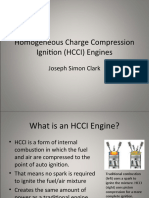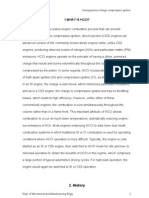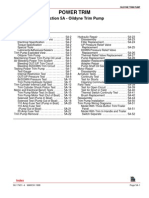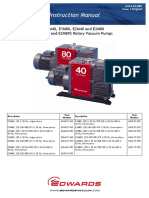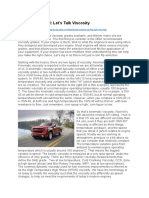0 ratings0% found this document useful (0 votes)
13 views19BQ5A0314
19BQ5A0314
Uploaded by
Sirisha AsadiThe document discusses Homogeneous Charge Compression Ignition (HCCI) engines, which use autoignition to combust air-fuel mixtures. HCCI engines have higher efficiency and lower emissions than traditional engines but are difficult to control. Control methods include variable compression ratio, induction temperature, and valve actuation. While promising, HCCI engines also have challenges including higher cylinder pressures and emissions during certain operations.
Copyright:
© All Rights Reserved
Available Formats
Download as PDF, TXT or read online from Scribd
19BQ5A0314
19BQ5A0314
Uploaded by
Sirisha Asadi0 ratings0% found this document useful (0 votes)
13 views14 pagesThe document discusses Homogeneous Charge Compression Ignition (HCCI) engines, which use autoignition to combust air-fuel mixtures. HCCI engines have higher efficiency and lower emissions than traditional engines but are difficult to control. Control methods include variable compression ratio, induction temperature, and valve actuation. While promising, HCCI engines also have challenges including higher cylinder pressures and emissions during certain operations.
Copyright
© © All Rights Reserved
Available Formats
PDF, TXT or read online from Scribd
Share this document
Did you find this document useful?
Is this content inappropriate?
The document discusses Homogeneous Charge Compression Ignition (HCCI) engines, which use autoignition to combust air-fuel mixtures. HCCI engines have higher efficiency and lower emissions than traditional engines but are difficult to control. Control methods include variable compression ratio, induction temperature, and valve actuation. While promising, HCCI engines also have challenges including higher cylinder pressures and emissions during certain operations.
Copyright:
© All Rights Reserved
Available Formats
Download as PDF, TXT or read online from Scribd
Download as pdf or txt
0 ratings0% found this document useful (0 votes)
13 views14 pages19BQ5A0314
19BQ5A0314
Uploaded by
Sirisha AsadiThe document discusses Homogeneous Charge Compression Ignition (HCCI) engines, which use autoignition to combust air-fuel mixtures. HCCI engines have higher efficiency and lower emissions than traditional engines but are difficult to control. Control methods include variable compression ratio, induction temperature, and valve actuation. While promising, HCCI engines also have challenges including higher cylinder pressures and emissions during certain operations.
Copyright:
© All Rights Reserved
Available Formats
Download as PDF, TXT or read online from Scribd
Download as pdf or txt
You are on page 1of 14
Seminar on
HOMOGENEOUS CHARGE COMPRESSION IGNITION (HCCI)
ENGINE
Presented
by
G.Manoj
19bq5a0314
What is an HCCI engine ?
• HCCI engine is a combination of both spark ignition and
compression ignition engine in which fuel and air are
compressed to the point of auto ignition.
• There is no need of spark plug to ignite the air fuel mixture.
• Creates the same amount of power as a traditional engine but
uses less fuel.
Working Of HCCI Engine:
• It consists of Four strokes
i. Suction stroke : Fuel air mixtures enters into the engine
cylinders through inlet valve.
ii. Compression stroke : Piston moves from BDC to TDC
iii. Combustion stroke : Auto ignition takes place due to
compression.
iv. Exhaust stroke : Removal of exhaust gases from the engine
cylinder through exhaust valve into atmosphere.
Comparison with other Conventional Engines :
Future of HCCI Engine:
• The future of HCCI looks promising.
• Major companies such as Mercedes Benz, Honda, Volkswagen
have invested in HCCI research.
• Preliminary prototype figures shows that HCCI cars can be used
in coming years.
Why HCCI ?
Control method of HCCI Combustion
• The Major drawback of HCCI engine is to control the auto
ignition it may cause damage to the engine.
• No direct control methods possible as in SI or CI engine.
• Various control methods are:
i. Variable compression ratio
ii. Variable induction temperature
iii. Variable valve actuation
Variable compression ratio:
• The geometric compression ratio can be changed with a
movable plunger at the top of the cylinder head.
• This concept used in diesel model aircraft engine.
Variable induction temperature :
• The Simplest method uses resistance heater to vary inlet
temperature but this method is slow.
• To over come this FTM (Fast Thermal Management) method is
used , it is accomplished by rapid mixing of cool and hot intake
air takes place achieving optimal temperature as required and
hence better control.
Variable valve actuation :
• This method gives finer control within combustion chamber.
• Involves controlling the effective pressure ratio.
• It controls the point at which the intake valve closes.
• If the closure is after BDC , the effective volume and hence
compression ratio changes.
Advantages:
• Can achieve up to 15% fuel savings
• Lower peak temperature leads to cleaner combustion/lower
emissions
• Can use gasoline, diesel, or most alternative fuels HCCI
automobiles could reduce greenhouse gas emissions.
• The peak temperature is lower than the SI Engine
• HCCI must be operated at very high compression ratios
resulting in high efficiency and clean exhaust gases
Disadvantages:
• Higher cylinder peak pressures may damage the engine.
• Auto-ignition is difficult to control.
• HCCI Engines have a smaller power range.
• High HC and CO emissions.
Reference :
• College of Engineering @ The University of Wisconsin-Madison, initiatives in
energy, health, nanotechnology, security, and information technology". Engr.
wisc.edu. Archived from the original on 2010-02-25. Retrieved 2014-03-31.
• Zhao, Fuquan; Asmus, Thomas W.; Assanis, Dennis N.; Dec, John E.; Eng,
James A.; Najt, Paul M. (2003). Homogeneous Charge Compression Ignition
(HCCI) Engines: Key Research and Development Issues. Warrendale, PA, USA:
Society of Automotive Engineers. pp. 11–12. ISBN 0-7680-1123-X.
• Warnatz, Jürgen; Maas, Ulrich; Dibble, Robert W. (2006). Combustion:
Physical and Chemical Fundamentals, Modeling and Simulation,
Experiments, Pollutant Formation (4th ed.). Berlin, Germany: Springer. pp.
175–176. ISBN 3-540-25992-9.
THANK YOU
You might also like
- Atlas Lathe Operations ManualDocument5 pagesAtlas Lathe Operations Manualursind80% (5)
- p9n83xd9 Kirby G 4 ManualDocument6 pagesp9n83xd9 Kirby G 4 Manualukie07031984No ratings yet
- TATA 407 Wiring DiagramDocument1 pageTATA 407 Wiring Diagramanon_75822362643% (7)
- Diesel Common Rail Injection Electronic Components ExplainedFrom EverandDiesel Common Rail Injection Electronic Components ExplainedRating: 3.5 out of 5 stars3.5/5 (7)
- Date Tehnice 436 ZXDocument6 pagesDate Tehnice 436 ZXMB ViorelNo ratings yet
- Electronic Throttle Body Datasheet 51 en 10726070795Document5 pagesElectronic Throttle Body Datasheet 51 en 10726070795Jose LealNo ratings yet
- Homogeneous Charge Compression Ignition (HCCI) EnginesDocument36 pagesHomogeneous Charge Compression Ignition (HCCI) EnginesSundar MahalingamNo ratings yet
- HCCI SeminarDocument20 pagesHCCI SeminarSandeep Pathak100% (1)
- Homogeneous+Charge+Compression+Ignition+ HCCI +enginesDocument7 pagesHomogeneous+Charge+Compression+Ignition+ HCCI +enginesChockalingam ChidambaramNo ratings yet
- Unit V Advanced Ic EngineDocument48 pagesUnit V Advanced Ic EngineEdward BernardNo ratings yet
- Ignition+ HCCI +enginesDocument7 pagesIgnition+ HCCI +enginesEder AcasieteNo ratings yet
- Homogeneous+Charge+Compression+Ignition+ HCCI +enginesDocument7 pagesHomogeneous+Charge+Compression+Ignition+ HCCI +enginesUpendra AryaNo ratings yet
- Cai HcciDocument7 pagesCai HcciheloverNo ratings yet
- Homogeneous Charge Compression Ignition (HCCI) EnginesDocument13 pagesHomogeneous Charge Compression Ignition (HCCI) Enginesnamrata chokakkarNo ratings yet
- Homogeneous Charge Compression IgnitionDocument17 pagesHomogeneous Charge Compression Ignitiondhananjayghule21No ratings yet
- HCCIDocument16 pagesHCCIchandruNo ratings yet
- Review On Homogeneous Charge Compression IgnitionDocument11 pagesReview On Homogeneous Charge Compression IgnitionANURAG KRISHNANo ratings yet
- Reference - Chapter - 5 - Recent Trends in IC EnginesDocument36 pagesReference - Chapter - 5 - Recent Trends in IC EnginesHarry ParryNo ratings yet
- HCCIDocument16 pagesHCCIArvind KaliaNo ratings yet
- Hcci EngineDocument36 pagesHcci EngineKiran Suresh100% (1)
- Hcci CAI-engineDocument36 pagesHcci CAI-engineheloverNo ratings yet
- Homogeneous Charge Compression Ignition HCCI Engine-PresentationDocument37 pagesHomogeneous Charge Compression Ignition HCCI Engine-PresentationtarunskumarNo ratings yet
- Homogeneous+Charge+Compression+Ignition+ HCCI +enginesDocument7 pagesHomogeneous+Charge+Compression+Ignition+ HCCI +engineschandruNo ratings yet
- Literature: (ISSN 2250-2459, ISO 9001:2008 Certified Journal, Strategies of Combustion Control For HCCI EngineDocument34 pagesLiterature: (ISSN 2250-2459, ISO 9001:2008 Certified Journal, Strategies of Combustion Control For HCCI EngineShivendra Upadhyay100% (1)
- Homogeneous Compression EngineDocument39 pagesHomogeneous Compression EngineUpendra AryaNo ratings yet
- Homogeneous Charge Compression Ignition EngineDocument12 pagesHomogeneous Charge Compression Ignition EngineHiền Lê ĐứcNo ratings yet
- A Met 201915Document5 pagesA Met 201915FRANCISCO JAVIER PRIETO CORONELNo ratings yet
- Homogeneous Charge Compression Ignition EnginehcciDocument36 pagesHomogeneous Charge Compression Ignition EnginehcciYogeshNo ratings yet
- Homogeneous Charge Compression Ignition EnginehcciDocument36 pagesHomogeneous Charge Compression Ignition EnginehcciAbhijitNo ratings yet
- Aut401 NotesDocument67 pagesAut401 Notesshaziya mehrinNo ratings yet
- Recent Trends: 5.1 Homogeneous Charge Compression Ignition EngineDocument14 pagesRecent Trends: 5.1 Homogeneous Charge Compression Ignition EnginesuriyaNo ratings yet
- HCCI EngineDocument15 pagesHCCI EnginePrathmesh BhattNo ratings yet
- 17 - Aljaberi Et AlDocument20 pages17 - Aljaberi Et AlSatriaAuliansyahNo ratings yet
- Lecture Notes On Advanced I C Engine Part I PDFDocument17 pagesLecture Notes On Advanced I C Engine Part I PDFl8o8r8d8s8i8v8No ratings yet
- HCCI, Lean BurnDocument43 pagesHCCI, Lean BurnArpit ThakurNo ratings yet
- Unit 5recenttrends 230829095521 A00a0692Document46 pagesUnit 5recenttrends 230829095521 A00a0692mohamed orifNo ratings yet
- Ijmerr v3n1 24Document12 pagesIjmerr v3n1 24Ioanna TsitraNo ratings yet
- Impact of Engine Emissions From Hcci Engine: An Overview: A.Devaraj, I.Vinothkanna, K.Manikandan & JishuchandranDocument6 pagesImpact of Engine Emissions From Hcci Engine: An Overview: A.Devaraj, I.Vinothkanna, K.Manikandan & JishuchandranTJPRC PublicationsNo ratings yet
- Advanced Ic Engines Unit 5Document18 pagesAdvanced Ic Engines Unit 5Ravi RajanNo ratings yet
- Unit 5 IceDocument8 pagesUnit 5 IceAnonymous bAoFyANo ratings yet
- Presented By: Sagar Patil (19MAE0020) Swapnil Chopade (19MAE0021) Yashpal Borse (19MAE0047)Document9 pagesPresented By: Sagar Patil (19MAE0020) Swapnil Chopade (19MAE0021) Yashpal Borse (19MAE0047)Sagar PatilNo ratings yet
- AljaberietalDocument21 pagesAljaberietalAndrés VitoNo ratings yet
- 8 AnapproachofexperimentalstudyonHCCIengine PDFDocument26 pages8 AnapproachofexperimentalstudyonHCCIengine PDFHuy Trần quangNo ratings yet
- Basics of IC EngineDocument37 pagesBasics of IC EngineNeetu AgarwalNo ratings yet
- 1.what Is Hcci?: Homogeneous Charge Compression IgnitionDocument17 pages1.what Is Hcci?: Homogeneous Charge Compression IgnitionAchal ShettyNo ratings yet
- Cme333 IvDocument35 pagesCme333 IvsnvijivikiNo ratings yet
- HCCIDocument45 pagesHCCIkrishterabox9No ratings yet
- Progress and Recent Trends in Homogeneous Charge CompressionDocument27 pagesProgress and Recent Trends in Homogeneous Charge CompressionPiyush JainNo ratings yet
- Seminar On: Gasoline Direct InjectionDocument25 pagesSeminar On: Gasoline Direct Injectionbij021100% (1)
- Modern Trends in Internal Combustion EnginesDocument15 pagesModern Trends in Internal Combustion EnginesMahmOud S. El-MashadNo ratings yet
- 74 MITNC-82 A. Dinesh 293-296 PDFDocument4 pages74 MITNC-82 A. Dinesh 293-296 PDFSachin Kumar J KNo ratings yet
- ICE ReportDocument7 pagesICE Reportreem.hosameldin03No ratings yet
- Ic Eng RedialDocument8 pagesIc Eng Redialomkartaksal42No ratings yet
- Developments in IC EnginesDocument41 pagesDevelopments in IC EnginesRohit K Murthy67% (3)
- Galgotias College of Engineering and TechnologyDocument13 pagesGalgotias College of Engineering and TechnologyAshish YaduvanshiNo ratings yet
- Homogeneous Charge Compression Ignition Engine: A Technical ReviewDocument6 pagesHomogeneous Charge Compression Ignition Engine: A Technical ReviewAnkush AgarwalNo ratings yet
- About EngineDocument2 pagesAbout Enginesrujanyadav12No ratings yet
- Homogeneous Charge Compression IgnitionDocument12 pagesHomogeneous Charge Compression IgnitionAkshayThakurNo ratings yet
- Lecture Notes On Advanced I.C. Engine Part-IDocument0 pagesLecture Notes On Advanced I.C. Engine Part-IJaiguru Narayanasamy0% (1)
- Assignment No: 3: NFC-IEFR-FaisalabadDocument4 pagesAssignment No: 3: NFC-IEFR-FaisalabadaliNo ratings yet
- The-4-Stroke-Engine-Power-CycleDocument10 pagesThe-4-Stroke-Engine-Power-Cyclemr.fahim22004No ratings yet
- Comparison of Diesel and Petrol EnginesFrom EverandComparison of Diesel and Petrol EnginesRating: 2.5 out of 5 stars2.5/5 (3)
- 372Document13 pages372Sirisha AsadiNo ratings yet
- 18BQ1A0337Document11 pages18BQ1A0337Sirisha AsadiNo ratings yet
- AID - A&B EWS LAB INT MARKS I SEM I MID MARKS ListsDocument18 pagesAID - A&B EWS LAB INT MARKS I SEM I MID MARKS ListsSirisha AsadiNo ratings yet
- 2-2 R20-Die DesignDocument18 pages2-2 R20-Die DesignSirisha AsadiNo ratings yet
- 19-05-2016 University Exam PaperDocument82 pages19-05-2016 University Exam PaperSirisha AsadiNo ratings yet
- Assignment 1, RAC - KME 601Document3 pagesAssignment 1, RAC - KME 601ANSH VERMANo ratings yet
- B224-FCC-LT-PID-111-11011 TO 11047 - LEGEND P&IDsDocument33 pagesB224-FCC-LT-PID-111-11011 TO 11047 - LEGEND P&IDsSahadev SinghaNo ratings yet
- Cylinder Block: ComponentsDocument3 pagesCylinder Block: ComponentsYannick de WalqueNo ratings yet
- Mechanical Supervisor Vol 2-1Document52 pagesMechanical Supervisor Vol 2-1sourabhsuman425No ratings yet
- Simple MachinesDocument30 pagesSimple MachinesuaragieNo ratings yet
- HUSABERG FE 450 2013: Spare Parts Manual: EngineDocument28 pagesHUSABERG FE 450 2013: Spare Parts Manual: EngineDaniel Eduardo Frias CasalNo ratings yet
- Genuine Eaton® Air System Parts, Kits and Assemblies For Top Shift PerformanceDocument4 pagesGenuine Eaton® Air System Parts, Kits and Assemblies For Top Shift Performancecristian picadoNo ratings yet
- Fans and BlowerDocument45 pagesFans and BlowerMad MaxNo ratings yet
- Consolidated BPOs WorkingDocument1,871 pagesConsolidated BPOs WorkinghaseebzkhanNo ratings yet
- Daihatsu Charade G10Document185 pagesDaihatsu Charade G10pikinos88% (8)
- DIMAXDocument27 pagesDIMAXKaren Tapia garciaNo ratings yet
- 68 - Daily Inspection Checklist For Launching GirdersDocument13 pages68 - Daily Inspection Checklist For Launching GirdersankitNo ratings yet
- Opearating InstructionsDocument26 pagesOpearating Instructionssvtechnique techniqueNo ratings yet
- Parts: Tension Rod and Toggle Plate Assembly: IllustrationDocument11 pagesParts: Tension Rod and Toggle Plate Assembly: IllustrationAshik Rahaman100% (2)
- KTM Training DIY CustomerDocument18 pagesKTM Training DIY Customerlainer chauxNo ratings yet
- Trim Motor ManualDocument52 pagesTrim Motor ManualJerry MooreNo ratings yet
- Principle of Ward Leonard MethodDocument2 pagesPrinciple of Ward Leonard MethodHazizi KhairyNo ratings yet
- Toyota SP200 Series ManualDocument55 pagesToyota SP200 Series ManualAno NymeNo ratings yet
- Bhelpswr - Co.in Technical FeedbackDocument7 pagesBhelpswr - Co.in Technical Feedbackradharaman_znaNo ratings yet
- Instruction Manual: E1M40, E1M80, E2M40 and E2M80 E2M40S and E2M80S Rotary Vacuum PumpsDocument64 pagesInstruction Manual: E1M40, E1M80, E2M40 and E2M80 E2M40S and E2M80S Rotary Vacuum PumpsDilson Barbosa RamosNo ratings yet
- Valvoline - Diesel Engine Oil - Let's Talk ViscosityDocument3 pagesValvoline - Diesel Engine Oil - Let's Talk Viscosityranjitv10No ratings yet
- Brother HL-1850, 1870n Parts ManualDocument27 pagesBrother HL-1850, 1870n Parts ManualDuplessisNo ratings yet
- 930t Wheel Loader 57z04000-Up (Machine) Powered by 3304 Engine (Sebp1949 - 00) - Documentación12Document8 pages930t Wheel Loader 57z04000-Up (Machine) Powered by 3304 Engine (Sebp1949 - 00) - Documentación12Pedro Luis Lopez SanchezNo ratings yet
- 4008 PDFDocument204 pages4008 PDFlungu mihai100% (1)
- Attia Pharm Attia: CustomerDocument3 pagesAttia Pharm Attia: CustomerbilalNo ratings yet










